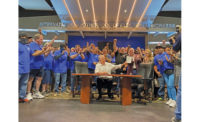Project Diversity Helps Light Up Helix Electric






“Helix’s staff was able to adapt and overcome all of the challenges that the project presented,” says Paul Schiffman, head of school. “We have done two major projects together, and they’re on our list for any future work.”
Helix is currently finishing work on the $1-billion Crescent Dunes Solar Energy Project, scheduled to begin operation later this year near Tonopah, Nev., about 190 miles northwest of Las Vegas. The 110-MW concentrating solar powerplant consists of 17,000 computer-operated heliostats—reflective mirrors that track and concentrate sunlight to a receiver atop a 538-ft-high tower to generate electricity. The project, which works like a lighthouse in reverse, requires roughly 200 miles of electrical wire with 10 miles of conduit. Helix has a standalone unit for solar work, with 1.2 GW of generation capacity installed to date.
Charting Work Force Solutions
Helix, a staunch nonunion advocate, has flourished partly through a reliable and skilled work force. The company provides more than 100 training courses annually, covering a myriad of management and technical topics. Helix offers opportunities for constant learning by staying busy with a complex, diverse and challenging array of work. The firm also encourages employee growth and advancement within the company while giving back to the community through staff-led charitable involvement.
“We have committed, long-term employees who share our company philosophy of delivering profitable performance and exceptional value,” Fuchs says. “We hire people that make the company successful.”
Success also comes from efficient project delivery through lean construction, which eliminates waste in design and construction-process waste though BIM, collaboration and prefabrication.
The company additionally uses technology for greater efficiency and reduced overhead costs. Helix, for example, has employees undergo a daily vehicle checklist on their phone that can be monitored by the fleet manager. Also, customers can sign off on work in the field using an iPhone form linked to the company’s database. Technicians can attach work progress photos and instantly e-mail signed work orders to both customers and office staff.
“This removes all paper forms from the field for the service department,” Fuchs says. “It has really helped streamline things and greatly improve service.”




